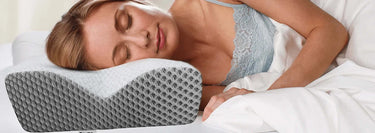Leg Support for Back & Side Sleepers: Knee and Hip Alignment
An innovative plan for pre-sleep and sleeping. Every day alignment for back and side sleepers

If you sleep on your back or side, your knees and hips decide whether the rest of your body gets to relax. Too much gap under the legs, and your lower back starts working overnight. Too little support between the knees, and your hips twist toward the mattress. Over time, that turns into morning tightness, restless sleep, and the constant search for a better position.
Leg pillows and wedges exist to solve that problem, but not all designs are equal. A soft block between the knees may feel cozy, yet do little to improve accurate hip alignment. A steep, rigid wedge can lift the legs so high that the lower back feels pulled instead of supported. Zen Bloks® takes a different approach: structured leg elevation and smart knee support that respect how real bodies move on real beds, night after night.
Why Back and Side Sleepers Struggle with Knee and Hip Alignment


On paper, back and side sleeping are often described as “neutral” positions. In real life, mattresses vary, bodies are asymmetrical, and gravity has its own agenda. The result is predictable:
- Back sleepers often have a visible gap under the knees. The legs are heavy, the lower back is slightly arched, and the lumbar region works through the night instead of resting.
- Side sleepers stack one knee over the other. Without something between the legs, the top knee drops forward, twisting the pelvis and adding rotational strain to the hips and lower back.
- Combination sleepers move between the back and side. Without structured support, each new position creates a new set of alignment challenges.
None of this means your body is “wrong.” It simply means that most beds do not provide targeted support for knees and hips. That is where leg pillows, wedges, and structured foam geometry step in.
How Leg Elevation and Knee Pillows Actually Change Alignment
A good leg support tool does two things at once:
- Rebalances weight across the thighs and calves, rather than letting one small area carry the load.
- Protects the hip line by preventing knees from collapsing inward or dropping forward.
That is why Zen Bloks® focuses on dual-angle elevation and high-density foam instead of soft, collapsing shapes. The wedge supports the entire length of the leg in a calm arc, while a knee pillow or small cushion can fine-tune hip alignment when you roll onto your side.
| Position | Without leg support | With structured leg support |
|---|---|---|
| Back sleeping | Knees drift toward extension, a gap under the legs, and the lower back can feel tension and stiffness. | Knees rest in a gentle bend, thighs and calves supported, and the lumbar area can settle into a more neutral curve. |
| Side sleeping | The top knee drops forward, the hips rotate, and the lower back and pelvis work to stabilize. | Knee support keeps legs stacked, hips stay more level, and the spine can follow a smoother line. |
The goal is not a perfect textbook diagram. The goal is to reduce unnecessary strain so your muscles don't quietly work all night.
Back Sleeper Setup: Using a Leg Wedge the Smart Way


Back sleepers are the easiest group to support with leg elevation, but the details still matter. A wedge that is too steep, too soft, or too short can turn support into a balancing act.
Step 1: Place the Wedge Close to the Hips
Position the wider base of the Zen Bloks® wedge near your hips so the dual-angle rise first supports the thighs, then the calves. Avoid leaving a gap between your hips and the wedge; that gap can pull on your lower back.
Step 2: Let the Knees Relax, Not Lock
Your knees should rest in a soft bend, not entirely straight and not sharply folded. The wedge’s upper angle carries the weight of the thighs so the knees feel light, not compressed. If your heels think too high, slide the wedge slightly down until the bend feels natural.
Step 3: Check Your Lower Back
As your legs settle, notice what happens to your lower back. Most people feel the lumbar area sink closer to the mattress as the wedge picks up leg weight. That is the sign that the support is doing its job, and the muscles around your spine can ease out of “work mode.”
For a visual walkthrough of this setup, see the dedicated leg elevation how-to guide in the Learn Center.
Step 4: Use Elevation as a Pre-Sleep Reset
Many back sleepers use the wedge for 15–30 minutes before falling asleep, then decide whether to keep it in place or transition to a flatter position. The key is consistency: a short, repeatable session each night does more for daily recovery than an occasional long session once a month.
Side Sleeper Setup: Knee Pillows, Leg Wedges, and Hip Line
Side sleepers face one extra challenge: gravity pulls the top leg toward the mattress. Without support, that leg wins, and the hips twist. The solution is not simply “something between the knees.” It is the right height, width, and foam structure to keep the hip line calmer.
How Side Sleepers Can Use a Leg Wedge
The Zen Bloks® leg wedge is designed primarily for back-lying elevation, but side sleepers can still use it strategically:
- Pre-sleep reset: Spend 10–20 minutes on your back with your legs elevated to ease lower-body fatigue and settle the hips before you roll to your side.
- Short side-lying sessions: Some users rest on their side with the lower leg partially supported by the wedge, then transition to a standard side-sleeping position with a smaller knee pillow.
In both cases, the wedge acts as a reset tool, helping your body release tension and find a more neutral baseline before you commit to a side-sleeping position for the night.
Where a Dedicated Knee Pillow Fits In
Once you roll onto your side, a smaller knee pillow or structured cushion between the thighs usually works better than a full wedge. The goal is to:
- Keep the top leg from dropping far forward.
- Reduce compression where the knees meet.
- Help the hips stay more level instead of twisting toward the mattress.
Many side sleepers do well with a firm, narrow pillow that sits between mid-thigh and knee level. Overly soft or oversized pillows tend to collapse or force the hips apart too aggressively, creating new tension rather than easing the old.
| Option | Common experience | Alignment impact |
|---|---|---|
| No knee pillow | Knees press together, top leg drops forward. | Hips rotate, lower back works to stabilize, and morning stiffness is more likely. |
| Very soft pillow | Feels cozy but compresses quickly overnight. | Support fades, knees drift back toward each other, hips lose alignment. |
| Structured, medium-firm knee pillow | Legs feel gently separated, knees cushioned without strain. | Hip line stays calmer, and lower-body tension often feels lower in the morning. |
In other words, side sleepers benefit from the same principle that drives the Zen Bloks® wedge: structured support over time beats quick softness on day one.
Knee and Hip Alignment Mistakes to Avoid
A few small changes can transform how your body feels at night. These are the most common issues we see in customer stories and testing sessions:
- Using a wedge that is too short: If your calves hang off the edge, your ankles and shins have to work to stay stable. The wedge should support from mid-thigh nearly to the heel.
- Choosing foam that is too soft: A plush wedge feels inviting, but often loses its angle in the first few weeks. High-density foam keeps the structure, so your alignment stays consistent.
- Placing the wedge too far from the hips: That gap forces the lower back to bridge unsupported space. Slide the wedge closer so the base catches the upper legs.
- Using a giant pillow between the knees: Oversized pillows can push the hips apart, causing a different strain. Aim for a comfortable, moderate width that keeps the legs stacked without forcing them.
- Only elevating when discomfort peaks: The best results come from short, steady routines. Waiting until tightness is at its worst makes it harder for the body to settle.
Building a Simple Nightly Routine with Zen Bloks®
You do not need a complicated program to support your knees and hips. A simple, repeatable flow is enough for most people:
- Evening reset on the wedge: Spend 10–20 minutes on your back with your legs elevated on the Zen Bloks® wedge. Breathe slowly, let your shoulders drop, and notice your lower back settling.
- Transition to your sleep position: If you are a side sleeper, roll to your preferred side with a structured knee pillow between your thighs. If you stay on your back, you can keep the wedge in place or move to a flatter posture depending on comfort.
- Support sitting time during the day: Combine your leg wedge routine with better sitting support. An ergonomic seat cushion, such as the Zen Bloks® XL gel cushion, helps keep posture more balanced during work, driving, or gaming so your body has less to correct at night.
For deeper guidance on timing and daily use, explore the When to Use a Leg Pillow article in the Learn section.
Foam Density, Height, and Sizing for Back and Side Sleepers
Two wedges might look similar in a photo, but feel entirely different in real use. The difference usually comes down to foam density, angle geometry, and height.
- High-density foam keeps its shape, supports the dual-angle profile, and holds alignment session after session.
- Low-density foam compresses quickly, flattening angles and letting the legs sink into positions that increase stiffness over time.
- Height matters because shorter users and taller users need different lofts to achieve the same comfortable knee bend.
Zen Bloks® wedges are tuned for this balance: firm enough to carry the legs without sagging, yet comfortable enough for long relaxation sessions. Many customers describe the feel as “structured floating” rather than stiff or rigid.
To compare heights and profiles, review the complete leg elevation wedge collection, and visit the ergonomic design overview for a deeper look at foam testing and geometry.
Back and Side Sleeper FAQ: Knees, Hips, and Leg Pillows
Q: Are leg pillows helpful for back and side sleepers?
Yes. Back sleepers use leg wedges to support the thighs and calves, allowing the lower back to relax into a more neutral curve. Side sleepers benefit from smaller knee pillows that keep the legs stacked and the hips more level. Both groups see alignment gains when support is structured rather than collapsing.
Q: What type of pillow works best for a side sleeper’s knees and hips?
Most side sleepers do well with a medium-firm, sculpted pillow that fits comfortably between the thighs and knees. The goal is gentle separation, not forcing the legs wide apart. Soft, low-density pillows tend to flatten and lose support overnight, reducing their alignment benefits.
Q: How should I use a leg wedge if I fall asleep on my side?
Think of the wedge as your pre-sleep reset. Use it on your back for 10–20 minutes to ease lower-body fatigue and calm the hips, then roll onto your side with a knee pillow in place. Some side sleepers choose to return to the wedge if they wake up during the night and want another short elevation session.
Q: How long should I keep my legs elevated if I have a lot of tightness?
Most people start with 15–30 minutes and adjust from there. Short, regular sessions often do more for knee and hip comfort than very long, occasional ones. Pay attention to how your body feels afterward and build a schedule you can maintain most days of the week.
Q: Can I combine leg elevation with stretching or light mobility work?
Yes. Many users do a brief mobility sequence for the hips and lower back, then finish with leg elevation on the wedge as a cool-down. That sequence helps reduce stiffness and supports a calmer transition into evening rest. For more ideas, explore the workout and recovery content in the Learn section.
Comfort and compliance note: Zen Bloks® products are designed for ergonomic comfort, posture support, and everyday lifestyle use. They are not healthcare devices and are not a substitute for professional guidance or care. Any references to user experiences reflect individual feedback. Comfort preferences and results vary from person to person.





